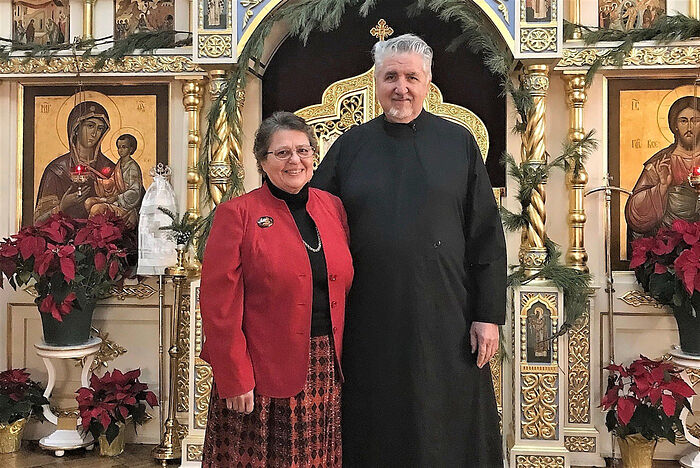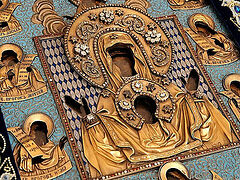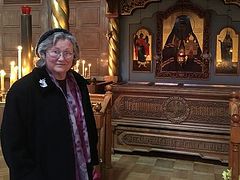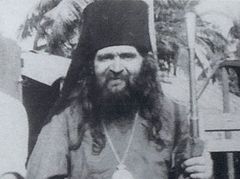 Protodeacon Nikolai and Nadezhda Mokhov in the ROCOR Cathedral of Our Lady of the Sign, New York City.
Protodeacon Nikolai and Nadezhda Mokhov in the ROCOR Cathedral of Our Lady of the Sign, New York City.
The future Fr. Nikolai Mokhov, a descendant of Don Cossacks and a protodeacon at the Russian Synodal Cathedral of Our Lady of the Sign for many years, was born in Luxembourg. But he was never a Luxembourger. Displaced persons and their descendants were not entitled to any European citizenship at all. So his first citizenship was American after his family moved to the USA in 1958.
If we take a closer look at the pedigree of this wonderful family, emigrants from Russia in different years contributed to the religious and cultural life of the country. Fr. Nikolai’s uncle, Mitered Archpriest Serge Poukh, together with his wife Emmie, a Luxembourger, built the Russian church in the capital of Luxembourg, reviving the dying parish. Emmie mastered Russian and Church Slavonic, learned to sing, conducted a small choir and read in the church. She knows entire services by heart; she restored the church after her husband’s death and now she helps its new rector. Fr. Nikolai’s parents sang in the church choir their entire lives, first in Luxembourg and then in New York.
The birthplace of his future wife Nadezhda was Germany, and her first citizenship, since 1951, has been American. She is a historian and an anthropologist by trade, as well as a translator and editor. Since her university years she worked on a popular UN project—space bridges, in which American and Soviet deputies, doctors, writers and priests participated. She worked as a manager in other joint American-Russian cultural projects as well.
They first met in New York as students of St. Sergius of Radonezh Russian Orthodox school at the ROCOR Synod of Bishops. The Cathedral of Our Lady of the Sign has been home to the wonderworking Kursk Root Icon of the Sign, and has been their parish since 1959. It is here that Nadezhda has worked on a voluntary basis behind the candle box and helped in the church in many ways for over fifty years.
Before the Revolution and afterwards
—Your ancestors were from Ukraine. What was their fate after the Revolution?
—Prior to the Revolution my grandfather, Mikhail Danilovich Yanevsky, was an agronomist near Kiev where he had estates and plots of land. After the October Revolution, he was arrested, but then released several times so that he could help organize the work at collective farms. Once things began to improve, he would be sent to prison or exile again.
In addition to my mother, Zinaida, there were two younger daughters in the family. In the early 1940s, they lived in Kiev. My mother studied to be an engineer, her sisters studied to be a surgeon and a teacher.
My grandfather died in 1941. My mother was doing an internship at a recording studio in Tashkent then. When she finally managed to return to Kiev, the Nazis were approaching the city. My grandmother, Anna Andreevna, was sent to dig trenches, and the Germans took my aunt to the front as a surgeon. My mother and other aunt were hired to work in the office, as they knew German and French well.
To Austria under fire
 With her grandma at the Lansgut Camp. 1950 In 1943, when the Nazis were leaving Kiev, my mother’s immediate boss (an Austrian who hated Germans) saved our family. He said to her that the next day they would be all taken out from work and sent with the retreating army. Mother managed to bring grandma secretly and hide her in a truck with things that the Nazis were taking with them. Later, in America, we would laugh at our grandmother, saying that she had been taken out of Kiev “like old junk.” They were put onto trains with blocked windows and taken under fire in an unknown direction.
With her grandma at the Lansgut Camp. 1950 In 1943, when the Nazis were leaving Kiev, my mother’s immediate boss (an Austrian who hated Germans) saved our family. He said to her that the next day they would be all taken out from work and sent with the retreating army. Mother managed to bring grandma secretly and hide her in a truck with things that the Nazis were taking with them. Later, in America, we would laugh at our grandmother, saying that she had been taken out of Kiev “like old junk.” They were put onto trains with blocked windows and taken under fire in an unknown direction.
 Beside the barracks at the Lansgut camp. 1950 When the railway was bombed, they trudged on foot through Austria until they reached Vienna, where at night they were locked in a basement—men and women together. The Germans were surprised that they lived decently and not like animals. At daytime they were taken out to work at a factory. From time to time, the prisoners were transferred from place to place, and by the end of the war, they ended up in the American zone in Lansgut, at the Schleissheim Displaced Persons’ Camp. There they lived in the barracks which had previously been occupied by American soldiers.
Beside the barracks at the Lansgut camp. 1950 When the railway was bombed, they trudged on foot through Austria until they reached Vienna, where at night they were locked in a basement—men and women together. The Germans were surprised that they lived decently and not like animals. At daytime they were taken out to work at a factory. From time to time, the prisoners were transferred from place to place, and by the end of the war, they ended up in the American zone in Lansgut, at the Schleissheim Displaced Persons’ Camp. There they lived in the barracks which had previously been occupied by American soldiers.
My father ended up in the same camp. Awaiting repatriation, Soviet prisoners of war lived in barracks surrounded by barbed wire. My mother, who then worked in the office, managed to make a certificate for my father that he was not subject to repatriation. The office workers used potatoes to make the stamps needed for such certificates, signed them with famous names and thus saved many prisoners. It was in Lansgut that my parents got married in 1945, and I was born in 1947.
Our life in the camp and the healing in front of the Kursk Root icon
—What do you remember from your life in the camp?
—I was a baby and only remember some details of everyday life. To add some variety to our meager diet, my mother and grandmother would pick mushrooms in a nearby forest. I remember American soldiers driving around on jeeps, happily waving at us and sometimes throwing sweets or oranges. But most Germans didn’t regard us as human beings.
Meanwhile several children in the camp, including me, contracted polio. I was paralyzed, and mother took me to a hospital. But there she was told to take me back home because I was going to die. But mother talked them into leaving me at the hospital, if only overnight, and rushed to pray for my healing in front of the Kursk Root Icon of the Sign in a church in that area. The next morning I got better, though the disease left its mark and I had to learn to walk all over again.
To America
—How did you manage to flee to America?
—It was hard to live among people who didn’t view us as human beings. My mother wanted to go somewhere, but not to the USSR where we would have been imprisoned. And she began to write appeals regarding our departure to America. We regularly checked long lists which showed who had been selected for which countries. For my mother, the top priority was to keep the family together, and she included my grandmother, my aunt and me in the list. By that time my father had already emigrated to America, but we were unaware of this.
In 1951, as part of an agreement with the American Red Cross and the Tolstoy Foundation, and with the help of my godmother, whose husband worked as a driver for an American general, we managed to depart for New York by a military transport steamship via Bremerhaven. The men were accommodated in the cabins, and the women and children—in the hold on five-level bunks. We were fed American food that our poor people had never seen before, having gone from the Revolution to the war and then the camps. But many got seasick easily, and the food in wooden boxes was thrown into the water against the wind. I remember food flying and sometimes the salad or bread would fall back onto the deck.
For our voyage, American soldiers gave us warm old blankets, army camping utensils, and they hammered together two boxes and put all our stuff there. Before our departure, the customs officers opened our boxes for checking and waved us through! Rumors had been spreading in the camp that there were neither garlic nor onions in America! And there were people who took it with them!
We still have those small wooden boxes at home. They kept a wall carpet from Tashkent, along with some photos that we were able to take with us.
New York, New York
—You descended from the deck of the steamer and found yourself in New York…
—My godmother from America sent me a dollar for the journey! On June 23, 1951, we arrived in New York and used the dollar: Mother bought a token for the subway for ten cents, a German newspaper to look for an apartment and job, and cleaning fluid for our future bathroom.
We were brought to 123rd Street in the Upper East Side and dropped off in the middle of the street. I remember the terrible heat, the mud and the horrible stench. We were sitting on our boxes, with people gathering around us.
Mother began to weep loudly. A plump Italian woman came up to her, hugged her, gave her a plastic rose and said that we would like it in America and everything would be fine. The rose in a glass vase stood on our fireplace for fifteen years until it fell apart when we moved to another apartment.
A day after arriving in New York, my mother went to look for an apartment. As she was walking along the street, she saw an elderly gentleman with a German newspaper in his hands. He turned out to be a landlord and rented out his apartment to us.
The place where our home was was then and still remains quite prestigious, with luxurious expensive houses. The apartment that we rented had two rooms, a shared toiled in the hallway for two families and a bath in the kitchen. Electricity and gas had been cut off due to the debts of the previous tenant. We found four beds in the street. I slept on the army bed given to us until I got married.
A few days later, my mother was hired to work at the Sunshine Biscuits confectionery factory. As a newcomer she was assigned to work on a conveyor belt during the night shift. Many representatives of various ethnic groups worked at the factory and were unfriendly to each other. In the afternoon, my mother would attend English courses. When she completed the course, she began to work at the American Express Company.
Over time, we obtained an oven and later decided as a family that if we lived more modestly, we would be able to buy a fridge. We lived in that apartment from 1951 to 1962.
My mother wasn’t active in the Church, though she did believe in God and taught me to respect everyone and to be a good person. When I was in the fifth grade in an American public school, my mother decided to send me to the Russian Saturday school at the Synod.
I paid for high school myself
—What kind of school was it?
—It was like a Sunday school in Russia. We were taught the Russian language and history, geography, music, the history of Russian culture and the Law of God. But when its principal, Archimandrite Anthony (Grabbe), learned that I could write well and knew the Law of God, he wondered if I wanted to study at St. Sergius’ High School (gymnasium). And I wanted to study there very much, feeling drawn to my own, familiar culture. It was difficult for me to be around American children who didn’t understand our strict way of life. The tuition was $900 per year. We didn’t have that money, but after I got a partial scholarship from a benefactor, Prince Sergey Sergeevich Belosselsky, I began to work off the remaining part of the tuition fee. Our students published the Gimnazist (“High School Student”) newspaper. The circulation was small, but it was still work. I edited texts, typed, selected photographs and helped Fr. Anthony in his office.
 Metropolitan Philaret plays with the children at the home of the Mokhovs. 1978 —Was it a full-fledged educational institution?
Metropolitan Philaret plays with the children at the home of the Mokhovs. 1978 —Was it a full-fledged educational institution?
—Yes, it was. Fr. Anthony (Grabbe) took the lead in its foundation. He secured the support of the city administration and attracted students and teachers.
The sponsor Sergey Semenenko was the first to revive the school in the new Synodal building, organize the high school and give the premises to the Synod. Prince Belosselsky with his wife, Prince Drutskoy and other sponsors donated generously to the school and its students. Metropolitan Philaret (Voznesensky), a teacher by profession who was elected the First Hierarch of ROCOR in 1964, became the school’s father-confessor and trustee.
At that time, there were twenty-one students in the high school. I began in the eighth grade, which had only one student before my arrival—Victor Magramm (now Archimandrite John). We both were nicknamed “terrorists” for our habit of bursting into the office noisily, frightening the head of the office, Princess Eletskaya.
 Metropolitan Philaret playing chess with children
Metropolitan Philaret playing chess with children
We studied alone for all of the eighth grade, and towards the end of the year, we were joined by a new student, Gleb Glinka (the future husband of Doctor Liza, and an attorney). In the ninth grade, there were already six of us, including my future husband.
Among the school teachers were former officers, people from high society and highly qualified educators. General subjects were taught by American teachers. Students received an excellent education, spoke two languages, and most entered famous American universities upon graduating (including Columbia and Fordham), worked in the UN and in the civil service. Despite its overall secular nature, one of the aims of the high school’s founders was to instill in the younger generation the spiritual values of the Orthodox Church, to pass on the spiritual heritage of Russia to them. Our morning would begin with joint prayer, on the major feasts we attended services at the Cathedral of Our Lady of the Sign or the lower St. Sergius Church, and lived by the Orthodox feasts.
Two “varenyes” and oil
—In high school you met Metropolitan Philaret, who became your spiritual instructor and a father figure…
—Metropolitan Philaret (Voznesensky) was the youngest bishop to head ROCOR after the elderly Metropolitan Anastasius (Gribanovsky) retired.
Soon after his arrival from Australia, he organized a club in the Synodal building, and among the first people he invited were my husband, Victor Magramm, Victor Potapov (the current rector of St. John the Baptist Cathedral in Washington D.C.), his wife Maria and some acolytes. My mother allowed me to join the club after she had herself visited it to see what Metropolitan Philaret was like and what he was doing with students. Vladyka himself would visit the club members to see the way they lived.
The club was our family. We could ask a wide range of questions, both serious and foolish ones, and even argue with Vladyka. Sometimes he took us to his parishes, or fishing. It was all extremely interesting to us, broadened our horizons and strengthened the sense of belonging to the Russian Orthodox diaspora.



